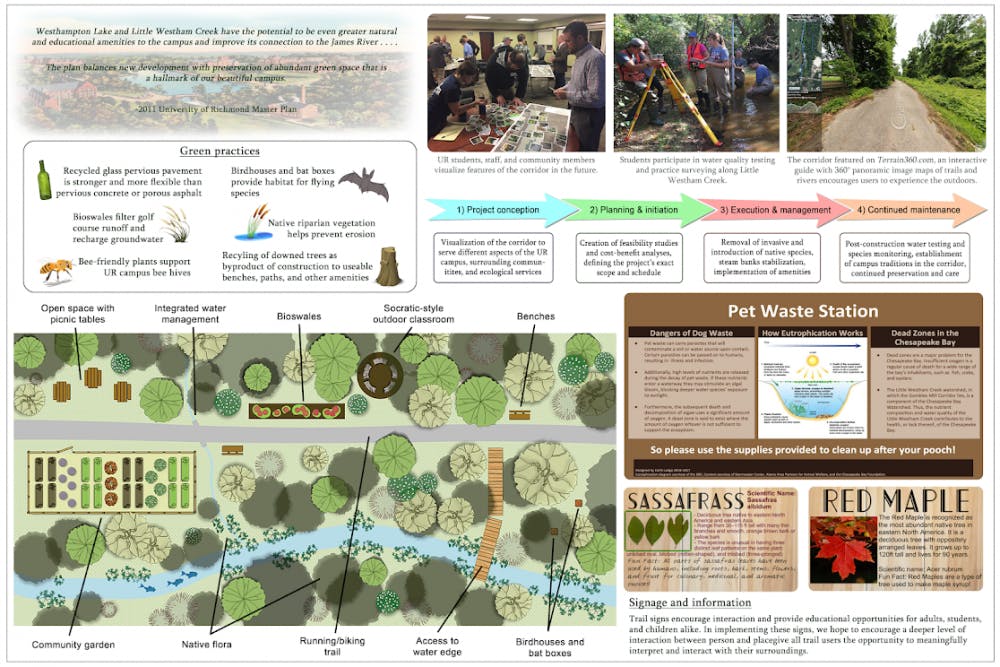Editor's note: This article was corrected to say Maggie Latimer's major of geography instead of environmental studies.
This spring, the University of Richmond plans to launch the construction of an “Eco-Corridor” that will provide students with an access site for nature.
The Eco-Corridor is part of a school plan that strives to encourage campus growth while also maintaining the aesthetic and ideological values on which the university was founded, according to University Facilities website.
In addition to the facilities department and the UR Office of Sustainability, environmental studies classes at the university have been helping to brainstorm ideas for this project since 2011.
The initiative will restore a trail next to the Country Club of Virginia golf course on the edge of campus, giving students a new place to enjoy the outdoors and be physically active.
The trail will follow Little Westham Creek, which runs from Westhampton Way to River Road Shopping Center, and down to the James River, Rob Andrejewski, the director of sustainably, said.
Little Westham Creek is a stream that forms from the spillway over the dam behind Tyler Haynes Commons. The water currently brings harmful nutrients, sediment and little pieces of litter into the James River, Andrejewski said.
As part of the Chesapeake Bay Foundation, the city of Richmond is federally and state mandated to minimize the levels of phosphorus, nitrogen and other pollutants in the city’s river.
“We, as stewards, need to recognize the upstream influence we have on the James River," Andrejewski said. "Rivers are the life and blood of the natural world, and we have a direct impact."
The Eco-Corridor project has the ability to change the shape of the river. In order to begin this process, UR will restore Little Westham Creek and the surrounding land, Andrejewski said.
UR is working with an environmental design firm, Waterstreet Studio. Together, they decided that the first step is the removal of invasive species, Andrejewski said.
The team will use biological, mechanical and chemical tactics. In order to limit the use of harmful chemicals in the process of eliminating these species, there will be goats on campus for eight weeks beginning in May, Andrejewski said. They will be penned in, provided with water and will feed on the invasive species, Andrejewski said.
Enjoy what you're reading?
Signup for our newsletter
“We created this integrated pest management plan years ago to try to be humane when there are any animal pests, and very environmentally sensitive when we are trying to control for our managed lands,” Andrejewski said.
Once the invasive species are removed and permits are granted, the rest of the project will be underway, Andrejewski said.
Last semester, UR held a community-input session to get ideas for the project and better understand what students and staff want from this development. Attendees suggested things such as outdoor fitness stations, safety lighting and a cleared reflection spot.
“The Eco-Corridor has been in the works for a while, so I am really excited that we are officially moving forward with the project,” said Paige Dunlap, senior and president of University of Richmond Sustainability Advocates. “A lot of decisionmakers have collaborated to make sure this corridor benefits the students. There will be a lot of opportunities for student involvement and education.”
While there are still many logistical aspects to be decided, such as the material for the top layer of the path, students are already working on signs to educate hikers and bikers about the native flora, fauna and local ecology, Andrejewski said.
The school hopes that the corridor will be a multi-functional area for recreation, academics, community involvement and beyond. It will also give students the ability to get to and from the James River without a car, something that Andrejewski said he believed would be exciting for members of the UR community.
Maggie Latimer, a senior geography major, is eager to return to UR to see the trail once it's completed, she said.
“It's been really rewarding to be part of the planning process so far and I can't wait to come back to campus a couple years post-graduation to see the trail in its full glory,” Latimer said. “I hope to one day see the Eco-Corridor be a significant, meaningful and treasured feature of UR.”
Contact contributor Kim Smith at kim.smith1@richmond.edu.
Support independent student media
You can make a tax-deductible donation by clicking the button below, which takes you to our secure PayPal account. The page is set up to receive contributions in whatever amount you designate. We look forward to using the money we raise to further our mission of providing honest and accurate information to students, faculty, staff, alumni and others in the general public.
Donate Now



